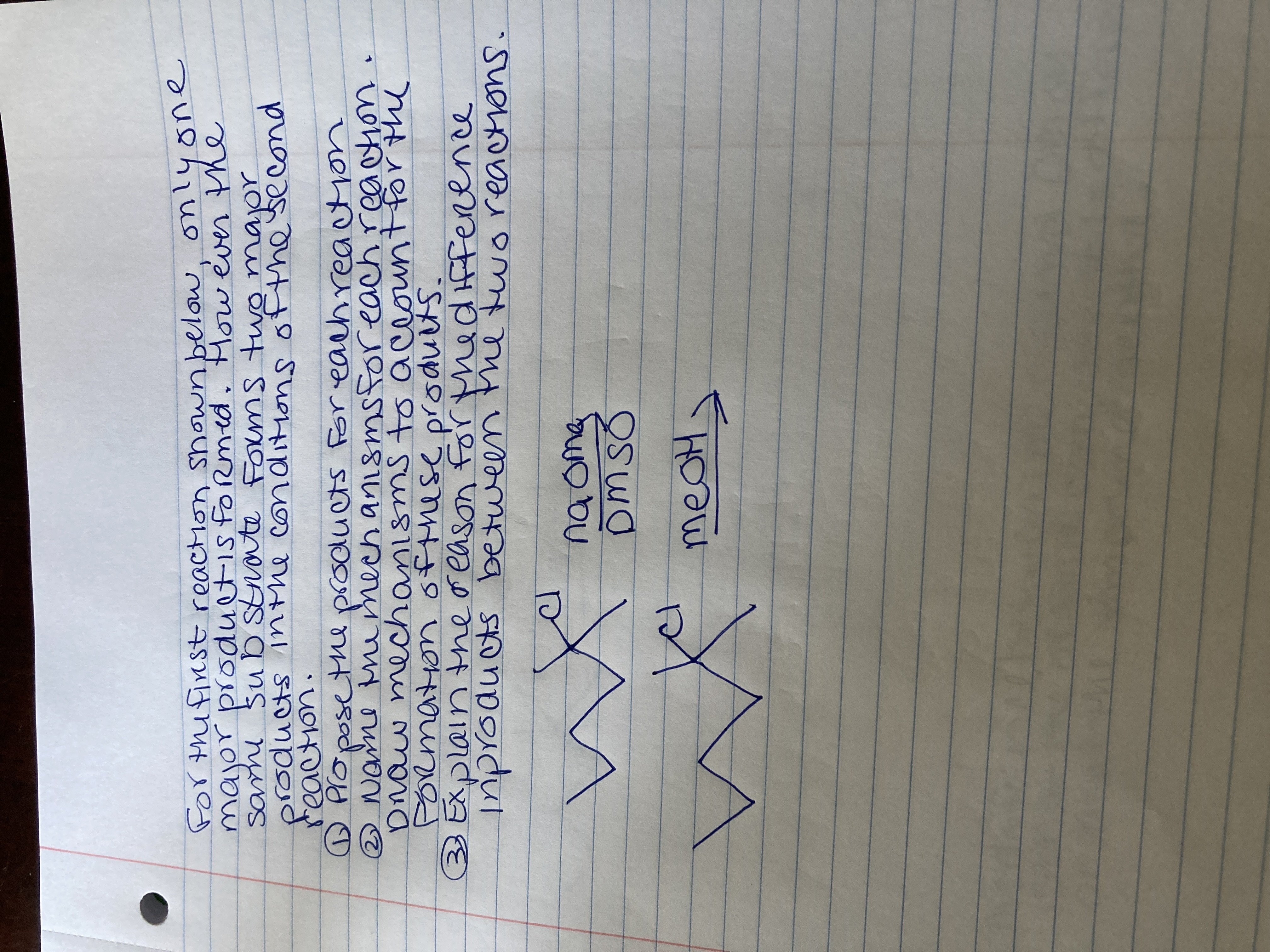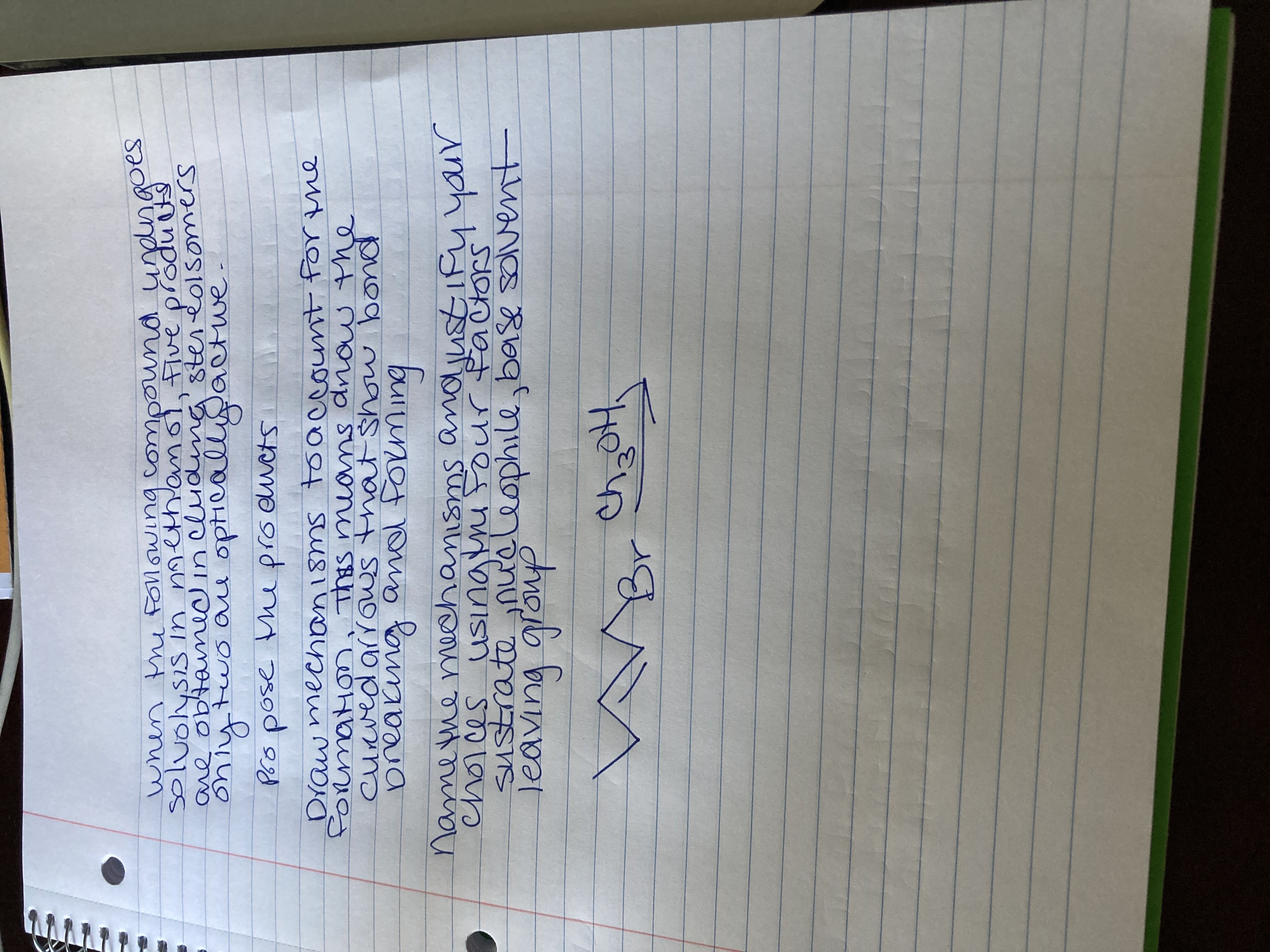
Chemistry
10th Edition
ISBN: 9781305957404
Author: Steven S. Zumdahl, Susan A. Zumdahl, Donald J. DeCoste
Publisher: Cengage Learning
expand_more
expand_more
format_list_bulleted
Question
Please help me solve these reactions

Transcribed Image Text:**Title**: Analysis of Chemical Reactions with a Common Substrate
**Introduction**:
In the study of organic chemistry, it's crucial to understand how a single substrate can lead to different products depending on the reaction conditions. Below is an analysis of two reactions involving the same substrate but resulting in different major products.
**Text**:
For the first reaction shown below, only one major product is formed. However, the same substrate forms two major products in the conditions of the second reaction.
1. **Propose the products for each reaction.**
2. **Name mechanisms for each reaction. Draw mechanisms to account for the formation of these products.**
3. **Explain the reason for the difference in products between the two reactions.**
**Diagrams and Chemical Structures**:
1. **Reaction 1**:
- A cyclohexane ring with a chlorine atom attached (drawn in a zigzag form to represent the structure).
- Reaction conditions: NaOme (sodium methoxide) in DMSO (dimethyl sulfoxide).
2. **Reaction 2**:
- The same cyclohexane ring with a chlorine atom attached.
- Reaction conditions: MeOH (methanol).
**Discussion**:
- Analyze how the choice of solvent and nucleophile affects the outcome of reactions.
- Consider factors like elimination vs. substitution based on reaction conditions.
- Provide a detailed mechanism for each reaction, illustrating the step-by-step transformation of the substrate into products.
**Conclusion**:
Understanding these reactions allows us to predict the outcomes based on various chemical conditions, which is essential for practical applications in synthesis and industrial chemistry processes.

Transcribed Image Text:**Transcription and Explanation for Educational Website**
---
**Chemistry Problem: Mechanisms and Products of Solvolysis**
When the following compound undergoes solvolysis in methanol, five products are obtained, including stereoisomers. Only two are optically active.
**Tasks:**
1. **Propose the Products:**
- Identify and describe the possible products formed during the solvolysis of the compound in methanol.
2. **Draw Mechanisms:**
- Illustrate the mechanisms accounting for the formation of the products. Use curved arrows to clearly indicate bond breaking and forming processes.
3. **Name the Mechanisms:**
- Specify the reaction mechanisms involved, considering the factors:
- Substrate
- Nucleophile
- Base
- Solvent
- Leaving group
**Compound Structure:**
- The compound is represented by a skeletal formula with a 4-carbon chain, a bromine (Br) substituent, and a methoxy group (CH₃OH) indicated as the solvent for solvolysis.
**Analysis:**
- Examine the structure to evaluate possible reactions:
- Consider the stability of carbocations and rearrangements.
- Assess the optical activity of different stereoisomers formed.
- Analyze how methanol, acting as both a solvent and a nucleophile, interacts with the substrate.
This exercise helps in understanding the nuances of reaction mechanisms and the factors influencing solvolysis reactions, especially in terms of stereochemistry and product distribution.
Expert Solution
This question has been solved!
Explore an expertly crafted, step-by-step solution for a thorough understanding of key concepts.
This is a popular solution
Trending nowThis is a popular solution!
Step by stepSolved in 5 steps with 3 images

Knowledge Booster
Learn more about
Need a deep-dive on the concept behind this application? Look no further. Learn more about this topic, chemistry and related others by exploring similar questions and additional content below.Similar questions
- Please complete the following reaction showing all arrow pushing mechanisms. What is the name of this reaction?arrow_forwardComplete the following synthetic transformation by selecting from the list of reagents below. Each reagent is labeled with a letter. In the drop down menus, select the order of reagents using capital letters. If no additional steps are required select "no additional steps". For example, if your synthesis involves using reagent A followed by B, and then C, you would select Step 1: A; Step 2: B, Step 3: C, step 4: no additional steps. Br BH3 A Br₂, light E HBr, peroxide I ? H₂O₂, NaOH B HBr F Hg(OAc)2, H₂O J OH NaBH4, NaOH C CrO3, pyridine G Br₂, H₂O K Na, NH, D CH,ONa H H₂O, H₂SO4 Larrow_forwardPlease write the mechanisms and the products for the 3 reactions.arrow_forward
- Please explain for both of these reactions why we get the correct numbers in front of the reacted alcohol and h2. how do we determine these numbers for example in the first reaction from 2 to 2 in the products and no number in front of h2 and then in the second reaction 6 and 2 to 2 and 3h2arrow_forwardPlease don't provide handwritten solutionarrow_forwardFor question 1a and 1b below, which of the puzzle pieces makes the best sequence for each synthesis? You must solve the syntheses with the puzzle pieces provide and nothing else. One piece can only be used once.arrow_forward
- Please don't provide handwriting solutionarrow_forwardPlease ignore the pen marks please on paper show step by step how to solve it correctlyarrow_forwardAccording to the proposed schemes, write the equations of reactions. Be sure to write down the formulas of substances. Triolein + bromine.arrow_forward
- This reaction will not work, please give two explanations why it won't.arrow_forwardmake sure it’s correct make sure drawing and explanation is cleararrow_forwardReaction B H Br EtOH H Br Figure 2 - Reaction Scheme B. In this method, stilbene is brominated using pyridinium bromide. Ethanol is used as the solvent. 40.0 mL of ethanol and 2.00 g of (E)-stilbene were placed in a 125 mL Erlenmeyer flask. The mixture was heated on a hot plate to dissolve the stilbene, after which 4.00 g of pyridinium tribromide was added to the mixture. After heating while stirring for 5 minutes, the Erlenmeyer flask was removed from heat, and the dibromide product was allowed to crystallize as the flask cooled to room temperature. Next, the mixture was chilled in an ice bath, and the product was collected by vacuum filtration, washing the crystals with 5.00 mL of ice-cold methanol. The product was allowed to air-dry, and obtained as white, needle-like crystals. Table 3: Usage and Waste Data for Scheme B Properties Amounts Used Excess / Waste Moles Compound MW (g/mol) Mass (kg) (mol) Stilbene 11.1 180.25 2.00 kg Ethanol Pyridinium 4g tribromide Methanol Product -H…arrow_forward
arrow_back_ios
SEE MORE QUESTIONS
arrow_forward_ios
Recommended textbooks for you
 ChemistryChemistryISBN:9781305957404Author:Steven S. Zumdahl, Susan A. Zumdahl, Donald J. DeCostePublisher:Cengage Learning
ChemistryChemistryISBN:9781305957404Author:Steven S. Zumdahl, Susan A. Zumdahl, Donald J. DeCostePublisher:Cengage Learning ChemistryChemistryISBN:9781259911156Author:Raymond Chang Dr., Jason Overby ProfessorPublisher:McGraw-Hill Education
ChemistryChemistryISBN:9781259911156Author:Raymond Chang Dr., Jason Overby ProfessorPublisher:McGraw-Hill Education Principles of Instrumental AnalysisChemistryISBN:9781305577213Author:Douglas A. Skoog, F. James Holler, Stanley R. CrouchPublisher:Cengage Learning
Principles of Instrumental AnalysisChemistryISBN:9781305577213Author:Douglas A. Skoog, F. James Holler, Stanley R. CrouchPublisher:Cengage Learning Organic ChemistryChemistryISBN:9780078021558Author:Janice Gorzynski Smith Dr.Publisher:McGraw-Hill Education
Organic ChemistryChemistryISBN:9780078021558Author:Janice Gorzynski Smith Dr.Publisher:McGraw-Hill Education Chemistry: Principles and ReactionsChemistryISBN:9781305079373Author:William L. Masterton, Cecile N. HurleyPublisher:Cengage Learning
Chemistry: Principles and ReactionsChemistryISBN:9781305079373Author:William L. Masterton, Cecile N. HurleyPublisher:Cengage Learning Elementary Principles of Chemical Processes, Bind...ChemistryISBN:9781118431221Author:Richard M. Felder, Ronald W. Rousseau, Lisa G. BullardPublisher:WILEY
Elementary Principles of Chemical Processes, Bind...ChemistryISBN:9781118431221Author:Richard M. Felder, Ronald W. Rousseau, Lisa G. BullardPublisher:WILEY

Chemistry
Chemistry
ISBN:9781305957404
Author:Steven S. Zumdahl, Susan A. Zumdahl, Donald J. DeCoste
Publisher:Cengage Learning

Chemistry
Chemistry
ISBN:9781259911156
Author:Raymond Chang Dr., Jason Overby Professor
Publisher:McGraw-Hill Education

Principles of Instrumental Analysis
Chemistry
ISBN:9781305577213
Author:Douglas A. Skoog, F. James Holler, Stanley R. Crouch
Publisher:Cengage Learning

Organic Chemistry
Chemistry
ISBN:9780078021558
Author:Janice Gorzynski Smith Dr.
Publisher:McGraw-Hill Education

Chemistry: Principles and Reactions
Chemistry
ISBN:9781305079373
Author:William L. Masterton, Cecile N. Hurley
Publisher:Cengage Learning

Elementary Principles of Chemical Processes, Bind...
Chemistry
ISBN:9781118431221
Author:Richard M. Felder, Ronald W. Rousseau, Lisa G. Bullard
Publisher:WILEY